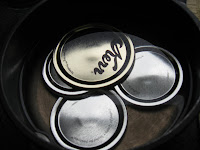I've been making a lot of jam. I was inspired by several cases of fruit from Mott's Fruit Stand in Sultan. But I'm still learning how to can. It's been a fun couple of weeks.
These are pictures of the nectarine preserve that I made on Monday. This is based on the
Tangy Apricot Jam recipe from the
Gourmet Cookbook, but I've tweaked it a bit.




First, I peeled the nectarines by plunging them whole into boiling water then immediately into an ice bath. The skins slip right off then. I then macerated the chopped nectarines with most of the recipe's sugar. This step takes a little longer, but it helps break down the fruit before cooking, so the jam tastes fresher. The next picture is of the macerated fruit the following day. Look at all that juice! The last photo of this set is the cooked preserve. After simmering and skimming for about 30 minutes, it takes another 25 minutes of low simmering to thicken.




Time to fill and process. I love how the ranks of jars look as they wait for their lids. After ten minutes in the boiling water
canner the cooled jars dry and seal on the counter. That "ping" they make always makes me smile.
Nectarine Preserves (based on the Tangy Apricot Jam from the
Gourmet Cookbook)
Ingredients:
5 pounds firm but ripe nectarines, peeled and pitted, chopped into 1/4 inch chunks
4 1/4 cups sugar
1/3 cup freshly squeezed lemon juice
1 (1
3/4-oz.) box pectin (optional)
Special Equipment:
Seven
1/2-pint canning jars with lids and screw bands, hot water
canner, tongs, canning tongs
Method:
After peeling, pitting and chopping nectarines toss them with 4 cups of sugar in a large bowl. Cover and refrigerate for at least 8 hours, or overnight.
Sterilize jars and lids and wash screw bands, according to jar manufacturer's recommendation.
Chill two plates for testing the jam.
Transfer the macerated nectarine mixture to a large pot. The sugar will not be completely dissolved. Stir in lemon juice. Bring this mixture to a boil over moderately high heat.
Stir frequently and skim off any foam that comes to the top. Simmer briskly for about 20 minutes.
Reduce the heat and continue to cook the preserves at a slow simmer. Stir the mixture frequently to avoid scorching. Begin testing jam for the desired thickness after about 25 minutes.
(To do this drop a small spoonful of jam onto a chilled plate, refrigerate for a minute, then tilt the plate. The jam should stay mounded, not run.)
If using pectin, whisk with remaining 1/4 cup of sugar in a small bowl. When jam is ready, whisk the pectin/sugar mixture into the hot jam. Return the mixture to a high simmer and cook preserves for another minute or so. (You don't need to use pectin for the nectarines, as they should have enough natural pectin to set the jam. But if they are particularly ripe, or you're worried about it setting it can help. It does cloud the flavor of the fruit very slightly.)
Drain your sterilized jars upside down on a clean kitchen towel for about a minute. Turn them over to receive the jam. Using a funnel, ladle the hot jam into each jar. It's best if the jam comes withing about a 1/4 inch of the top of the jar. I gently tap each jar on the counter to help settle the jam and remove any air pockets.
This amount of nectarines usually makes seven 1/2-pints of jam, but if you have a last jar that is half full, seal it and let it cool. Don't process it in the
canner. You can use this jam first, but you'll need to refrigerate it once it is cool.
Using a clean, damp towel wipe the tops of the jars. Seal jars with lids and screw bands. Add to hot water
canner and bring to boil. Process the jam for 10 minutes in the boiling water. Remove from the
canner and let the jam cool.
As the seals set on the jars, you should hear a "ping." If you don't hear this sound, don't worry. It's most important that the lids are concave on the jars. Another easy way to tell that the seal is set is this: once the jars are processed and cooled remove the screw band from one and see if you can get the lid off. It should be difficult to do this. If you are able to, the seal didn't set. Don't panic if this is the case. You can just refrigerate the jam and use it first. Jarred but unprocessed jam can last in your refrigerator for several months.
This jam tastes best if you let it sit at least a day for the flavors to develop. I usually squirrel away a couple of jars for the dead of winter and when the rain starts to get to me, I pop one open and remember the summer sunshine.


















































